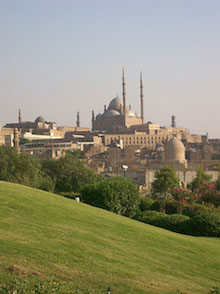EGYPT: Cairo rubbish dump converted into public park
Update: November, 2010
Al-Azhar Park continues to thrive in Cairo and has become a focal point for flora replenishment as well as cultural heritage conservation and community development. In 2005, Travel and Leisure magazine awarded the project its Global Innovation Prize.
89 varieties of trees, 51 types of shrubs, five species of grass, 50 groundcover plants, 14 climbers and 26 succulent plants have been propagated, along with herbs such as chamomile, mint, lemongrass, coriander and thyme. Nurseries have housed over two million plants and trees, of which 655,000 have been planted in al-Azhar. The remaining plants have been used in the courtyards and roof terraces of Cairo and to sell to garden contractors.
Other features include a museum, restaurant and café; a children’s play area, amphitheatre and stage; a selection of gardens adorned with marble columns; an orchard; playing fields; a lake and three fresh water reservoirs that supply Cairo with clean water.
Al-Azhar has inspired the launch of a much broader community rehabilitation programme, which encompasses a number of projects that are successfully developing the overpopulated and underfunded neighbourhood.
 |
 |
 |
Mohammad Ali Mosque from al-Azhar Park |
Darb al-Ahmar community development schemes
The Aga Khan Trust for Culture has gathered local charities, community institutions, district representatives, local businesses, workers and inhabitants to operate these schemes. This diverse cross-section of society enabled a detailed survey to be carried out on the socioeconomic needs of the entire area. Priorities were education, sanitation, housing and building renovation, waste, health and the necessity of a community centre.
Renovation activities have had a major impact on the district. Three projects formed the focal points of the work: damage to the Umm al-Sultan Shaaban Mosque following 1992’s earthquake has been repaired, its roof stabalised and parts of the minaret have been reconstructed. The previously disused Khayrbek complex now hosts offices and space for administrative training classes and the former Darb Shoughlan School now houses a new community centre, a library and AKTC offices.
This activity has contributed to the 150 apprenticeship placements in IT, automobile electronics, mobile phone services, masonry, carpentry, tourism, furniture making and office work. Traditional craft and labour skills have been revisited and training has included the restoration of stylised windows (mashrabiyya) and production of tiles using the forgotten technique of opus sectile. In addition, an adult literacy programme has been enforced.
Employment rates in the district have increased dramatically as a result of this training and the microcredit programme, which has supported a variety of local businesses, from shoemakers to dry cleaners and Internet cafes.
To support these enterprises, a business centre has been set up and health care service has been improved by a new clinic; 19 community-owned houses have been constructed, providing homes for approximately 70 families.
For a thorough guide through the development, please view this pdf file from The Aga Khan Trust for Culture.
When the Al–Azhar park project was first conceived - following His Highness the Aga Khan’s decision to donate a park to the citizens of Cairo in 1984 - the idea was to provide the metropolis with much–needed green space at the heart of its historic agglomeration. The motivation arose out of the Islamic belief that we are all trustees of God’s creation and therefore must seek to leave the world a better place than it was when we came into it.
A 30–hectare site on al–Darassa was selected because of its enormous potential as a ‘lung’ at the very centre of the historic agglomeration. Before work started, al-Darassa was a municipal rubbish dump.
However, when the excavation of the hilly site began, a historic wall was progressively revealed — eventually 1.3 kilometres of it — which then led to another major task: giving a new ‘face’ to the historic city as seen from the Park.
Eventually, the conservation project for the Ayubbid Wall itself - being inseparable from the abutting historic city fabric - led the Aga Khan Trust for Culture to consider a third programme, which was the launch of a combined physical and social rehabilitation process in the neighbouring area of the Park, the very poor Darb al–Ahmar district.
It was clear that the construction of the park and conservation of the historic wall could and should act as stimuli for the rehabilitation of Darb al–Ahmar, which is home to 240,000 people as well as some of Cairo’s most distinguished religious and secular monuments.
The Trust has initiated a range of community–based urban upgrading projects that contribute to the improvement of living conditions around the Park by providing the local people with cultural, social, economic and institutional support.
|

